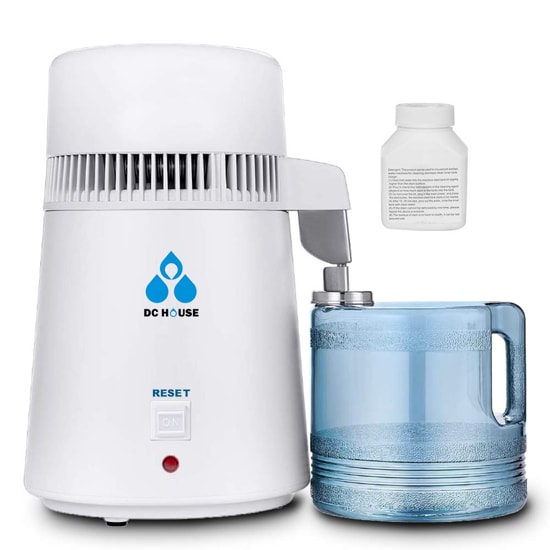The Environmental Protection Agency (EPA) has set the maximum contamination level (MCL) to 1.3 mg/L in drinking water. A healthy adult requires up to 0.9 mg of copper daily as it helps in energy production, immunity, and nervous system development. Copper above 1.3 mg/L is harmful. This article discusses different ways you can use to remove copper from drinking water.

6 Methods to Remove Copper from Drinking Water
1. Reverse Osmosis Filter
Reverse Osmosis (RO) water filters are best for removing copper (up to 99%) and other heavy metals, VOCs, TDS, sediment, and 99% of all contaminants in water.
A typical RO system consists of 4-7 filtration stages comprising a sediment filter, carbon filters, RO membrane, post-RO carbon filter, UV filter, and remineralization stage. The last two filters are optional and usually present in high-end models.
The heart of an RO system is the RO membrane, with a 0.01 to 0.00001-micron rating. It is so small that it hardly allows water to pass through. RO units come with a water tank to store filtered water. These units are typically under sink filters but are available as countertop and whole-house units.
Please note that RO filters waste 1-3 gallons of water for every gallon they filter. These filters also require periodic filter replacement and overall maintenance.
The biggest plus point is the water quality. RO filters produce water better than bottled water and save thousands of plastic bottles from going into landfills.

2. Activated Carbon Filters
Activated carbon filters come as standalone units or as a part of multi-stage filters. Activated carbon filters can remove up to 95% copper from drinking water and other absorbable contaminants. These filters are also best for removing chlorine and taste from water.
Activated carbon filters are cheap and effective but require periodic filter replacement like other cartridge filters. You don’t need to install an additional filter to remove copper if your current treatment unit has an activated carbon filter.
3. Water Distillation
Water distillation is an effective way to remove up to 99% of copper from drinking water. A water distiller works by boiling water and then condensing the steam to produce copper-free water.
Water distillers are available in many shapes and sizes. It is mostly used in commercial settings to produce distilled water.
Water distillation has its advantages and drawbacks. It removes essential minerals from water, making its taste bland.

4. Water Softeners
Water softeners are typically used to remove calcium and magnesium from hard water. However, some softeners are designed to remove copper and iron as well.
Softeners use softening salt to remove calcium, magnesium, copper, and iron from water and add sodium or potassium ions during the ion exchange process.
A water softener is great for homes with hard water and copper. However, removing copper impacts the softener’s ability to perform its primary function; making the water soft. It happens because copper and iron ions get deposited on the resin bed, and the resin beads aren’t fully flushed during regeneration.
Water softeners also require periodic salt replacement and a brine discharge arrangement. Some states don’t allow water softeners owing to environmental concerns; please check local laws before installing a water softener.

5. Acid Neutralizers
Acid neutralizers are typically used to increase well water pH. It makes well water less acidic and removes up to 60-70% copper from well water.
An acid neutralizer is a whole house unit and recommended for homes with a low concentration of copper. Make sure you get your water tested before installing an acid neutralizer.

6. Flushing Your Water System
It is an instant remedy to remove copper from water that enters water due to copper pipes. All you have to do is open the tap and let it run for 30 seconds before using water. You can collect this water in a bucket for watering the plants or cleaning around your home.
It is a one-time solution for people that don’t have any copper treatment options at home, as it doesn’t address the root cause. Moreover, it is recommended to use cold water for cooking and drinking as hot water dissolves copper quickly and has a high concentration of copper ions. You can check this by simultaneously testing hot and cold water at home.
How does Copper enter Drinking Water?
Water dissolves copper when it moves underground over soil and rocks, erosion of copper pipes and household plumbing fixtures and appliances.
Symptoms of Copper in Drinking Water and Home Appliances.
- Stains in the shower
- Blue-green stains in the sink and faucet
- Black or blue-green film inside the hot water tank
- Discoloration of laundry
- Metallic taste in water
Frequently Asked Questions
1. Can boiling water help get rid of copper?
No, the boiling water doesn’t reduce the copper levels. In fact, if your water has copper in it, boiling may increase its levels. However, condensing the steam produces copper-free water as copper stays in the boiling pot because it has a higher boiling point than water.
2. How to test for copper in water?
You can use a home testing strip or send a water sample to a lab. Most homeowners use testing strips. It works by changing colors when dipped in a water sample. You can then compare the results with a reference chart.
3. Is drinking copper water harmful?
Yes. Drinking water with excessive copper is bad for your health. It can cause vomiting, diarrhea, nausea, and stomach cramps. Prolonged exposure can lead to liver diseases and even death in rare cases.
4. Can copper affect pool water?
Yes. Excessive amounts of copper in pool water can stain the pool surface, your swimsuits, nails, and hair. Copper enters pool water through pipes or when untreated groundwater is used to fill the pool. It is also added to water to kill algae. To avoid stains, you must ensure that its concentration is below 1.0 mg/L in pool water.

Leave a Reply